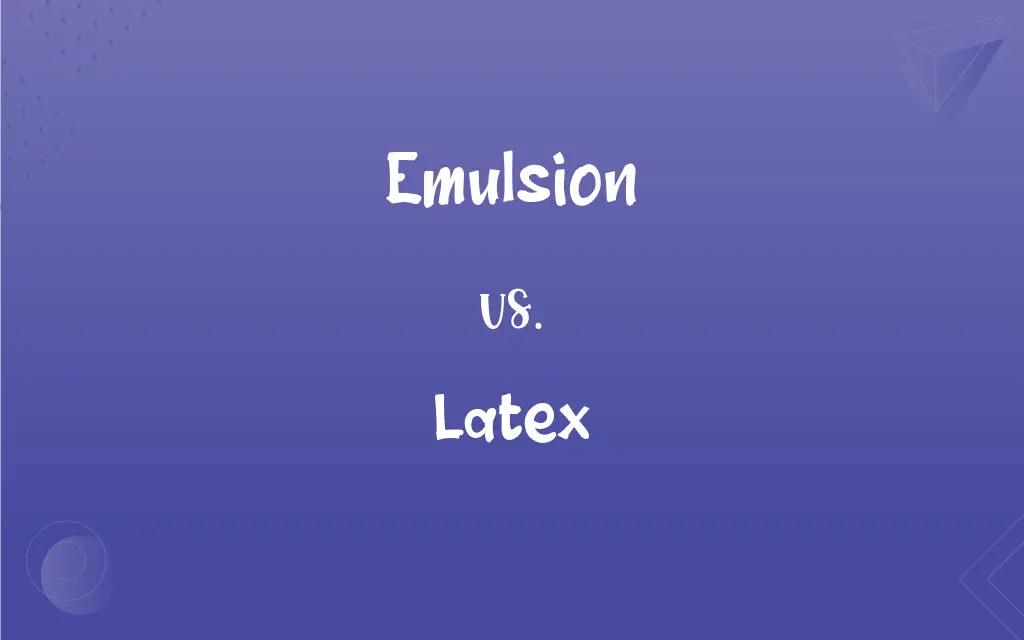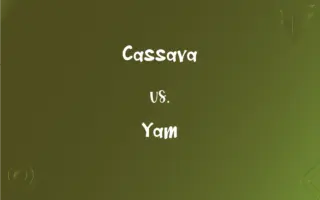Emulsion vs. Latex: What's the Difference?
Edited by Harlon Moss || By Janet White || Published on October 16, 2023
An emulsion is a mixture of two unblendable substances, often oil and water, while latex is a natural or synthetic dispersion of polymer particles in water.

Key Differences
An emulsion pertains to the dispersion of one liquid in another immiscible liquid, commonly oil in water or vice versa. On the other hand, latex refers to a dispersion of polymer particles, either natural or synthetic, in water.
Emulsions find their place in various fields, from culinary arts where salad dressings like vinaigrettes are prepared, to cosmetics and pharmaceuticals. Latex, in contrast, is extensively used in the manufacture of rubber products, paints, and certain adhesives.
Emulsions typically require stabilizing agents, or emulsifiers, to prevent the separated phases from coalescing. Meanwhile, latex preparations often incorporate stabilizers to preserve the dispersion and prevent the particles from agglomerating.
Emulsions can vary in their appearance, ranging from milky to opaque, based on the droplet size and concentration of dispersed phase. Latex, in general, appears milky because of its dispersed polymer particles in water.
Emulsions are essentially combinations of immiscible liquids stabilized by emulsifiers. Latex can be of natural origin, like the sap from rubber trees, or synthetic, formulated from specific polymer dispersions.C
ADVERTISEMENT
Comparison Chart
Nature
Dispersion of two immiscible liquids.
Dispersion of polymer particles in water.
Common Uses
Food, cosmetics, pharmaceuticals.
Rubber, paints, adhesives.
Stabilization
Requires emulsifiers.
Often uses stabilizers.
Appearance
Can range from milky to opaque.
Typically milky.
Origin
Combination of liquids.
Natural (e.g., rubber tree sap) or synthetic.
ADVERTISEMENT
Emulsion and Latex Definitions
Emulsion
Often stabilized with emulsifiers.
The lotion's emulsion was stabilized with natural emulsifiers.
Latex
Dispersion of polymer particles in water.
The paint contained acrylic latex for durability.
Emulsion
Varies in consistency based on droplet size.
The emulsion appeared milky due to its fine droplets.
Latex
Natural sap of certain plants.
Rubber is derived from the latex of rubber trees.
Emulsion
Mixture of two unblendable liquids.
Mayonnaise is an emulsion of oil and vinegar.
Latex
Used in making rubber products.
The gloves were made of natural latex.
Emulsion
A liquid dispersed in another immiscible liquid.
The chef made an emulsion of lemon juice and olive oil.
Latex
Can be natural or synthetic.
The mattress had layers of synthetic latex.
Emulsion
A suspension of small globules of one liquid in a second liquid with which the first will not mix
An emulsion of oil in vinegar.
Latex
Often appears milky in consistency.
The latex paint had a smooth, milky texture.
Emulsion
A photosensitive coating, usually of silver halide grains in a thin gelatin layer, on photographic film, paper, or glass.
Latex
The colorless or milky sap of certain plants, such as the poinsettia or milkweed, that coagulates on exposure to air.
Emulsion
A stable suspension of small droplets of one liquid in another with which it is immiscible.
Mayonnaise is an emulsion where egg is used to keep oil and water mixed.
Latex
A polymer emulsion consisting of such sap obtained from rubber trees, used to manufacture various thin elastic products such as balloons, disposable gloves, and medical and contraceptive devices. Some people are allergic to this substance. Also called natural rubber latex.
Emulsion
(chemistry) A colloid in which both phases are liquid.
Latex
A similar material made from polymers derived from petroleum; synthetic latex.
Emulsion
(photography) The coating of photosensitive silver halide grains in a thin gelatine layer on a photographic film.
Latex
Latex paint.
Emulsion
Any liquid preparation of a color and consistency resembling milk; as: (a) In pharmacy, an extract of seeds, or a mixture of oil and water united by a mucilaginous substance. (b) In photography, a liquid preparation of collodion holding salt of silver, used in the photographic process.
Latex
A clear liquid believed to be a component of a humour or other bodily fluid esp. plasma and lymph
Emulsion
(chemistry) a colloid in which both phases are liquids;
An oil-in-water emulsion
Latex
The milky sap of several trees that coagulates on exposure to air; used to make rubber.
Emulsion
A light-sensitive coating on paper or film; consists of fine grains of silver bromide suspended in a gelatin
Latex
An emulsion of rubber in water, used in adhesives and the like.
Emulsion
Common in food and cosmetics.
The sauce had a smooth emulsion consistency.
Latex
(uncountable) Natural latex rubber, especially non-vulcanized rubber, such as is used in making latex gloves, latex condoms, and latex clothing.
Latex
A milky or colored juice in certain plants in cavities (called latex cells or latex tubes). It contains the peculiar principles of the plants, whether aromatic, bitter, or acid, and in many instances yields caoutchouc upon coagulation. The lattex of the India rubber plant produces the rubber of commerce on coagulation.
Latex
Any aqueous emulsion of finely divided rubber or plastic particles, especially such an emulsion used as a base for paint; as, a latex paint.
Latex
A milky exudate from certain plants that coagulates on exposure to air
Latex
A water-base paint having a latex binder
FAQs
Is latex always natural?
No, latex can be natural or synthetic.
What's the main component of an emulsion?
It's a mix of two immiscible liquids.
What products commonly contain latex?
Rubber gloves, paints, and balloons.
How do emulsions appear?
They can range from milky to opaque.
What is synthetic latex derived from?
It's made from specific polymer dispersions.
Is latex in all paints?
No, but latex paints are popular due to their water-based nature.
Why are emulsifiers used in emulsions?
To stabilize and prevent separation.
Can emulsions be found in food?
Yes, like in salad dressings or mayonnaise.
Are latex allergies common?
Yes, some people are allergic to natural rubber latex.
Can emulsions be broken?
Yes, they can separate without proper stabilizers.
Why is latex used in mattresses?
For its comfort, elasticity, and durability.
How is natural latex harvested?
From the sap of rubber trees.
Can emulsions be found in pharmacies?
Yes, many medicines and creams are emulsions.
What causes latex allergies?
Proteins in natural rubber latex can trigger reactions.
Can emulsions be oil in water or water in oil?
Yes, both types exist.
Are there alternatives for those allergic to latex?
Yes, synthetic latex or other materials are available.
Are emulsions used in cosmetics?
Yes, many creams and lotions are emulsions.
Is every milky liquid an emulsion?
Not necessarily, appearance alone doesn't determine it.
Are emulsions stable?
They can be, especially with added emulsifiers.
What's a key characteristic of latex?
Its ability to coagulate when exposed to air.
About Author
Written by
Janet WhiteJanet White has been an esteemed writer and blogger for Difference Wiki. Holding a Master's degree in Science and Medical Journalism from the prestigious Boston University, she has consistently demonstrated her expertise and passion for her field. When she's not immersed in her work, Janet relishes her time exercising, delving into a good book, and cherishing moments with friends and family.
Edited by
Harlon MossHarlon is a seasoned quality moderator and accomplished content writer for Difference Wiki. An alumnus of the prestigious University of California, he earned his degree in Computer Science. Leveraging his academic background, Harlon brings a meticulous and informed perspective to his work, ensuring content accuracy and excellence.








































































